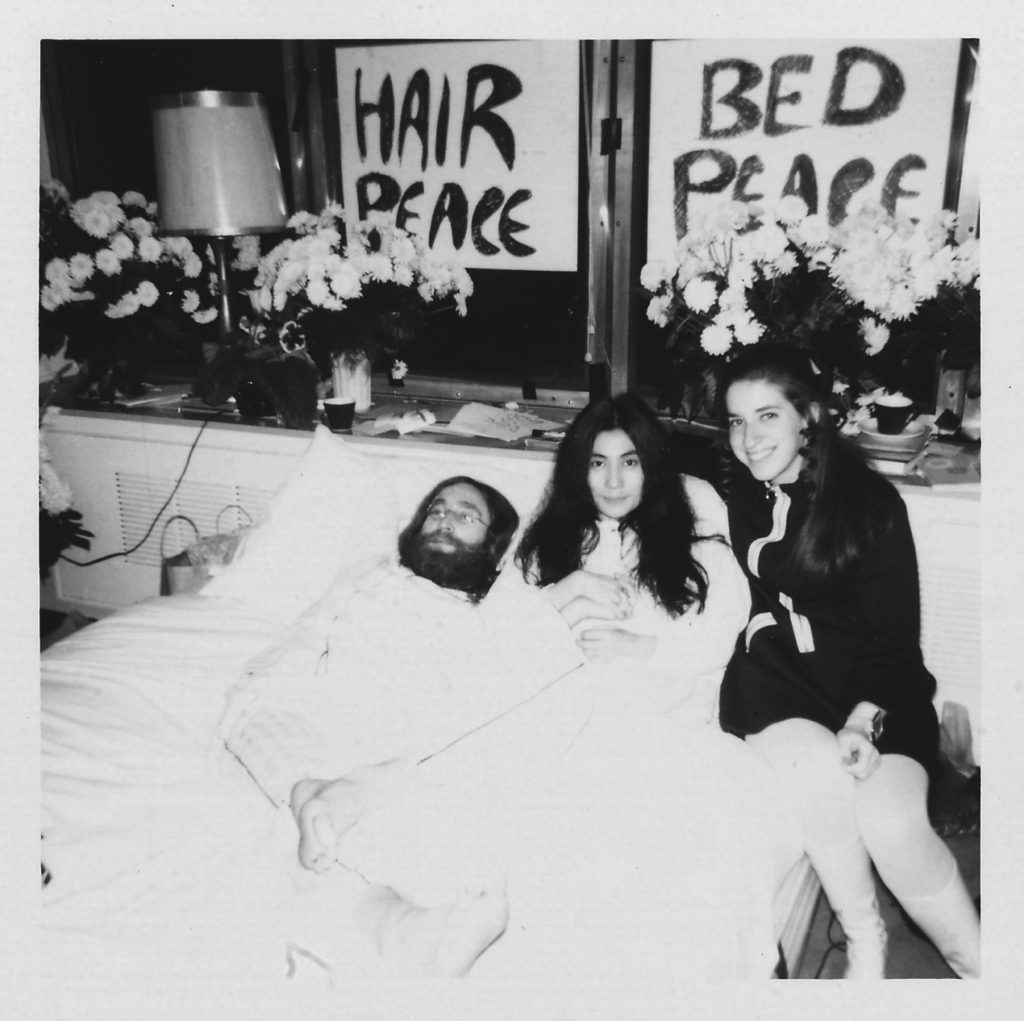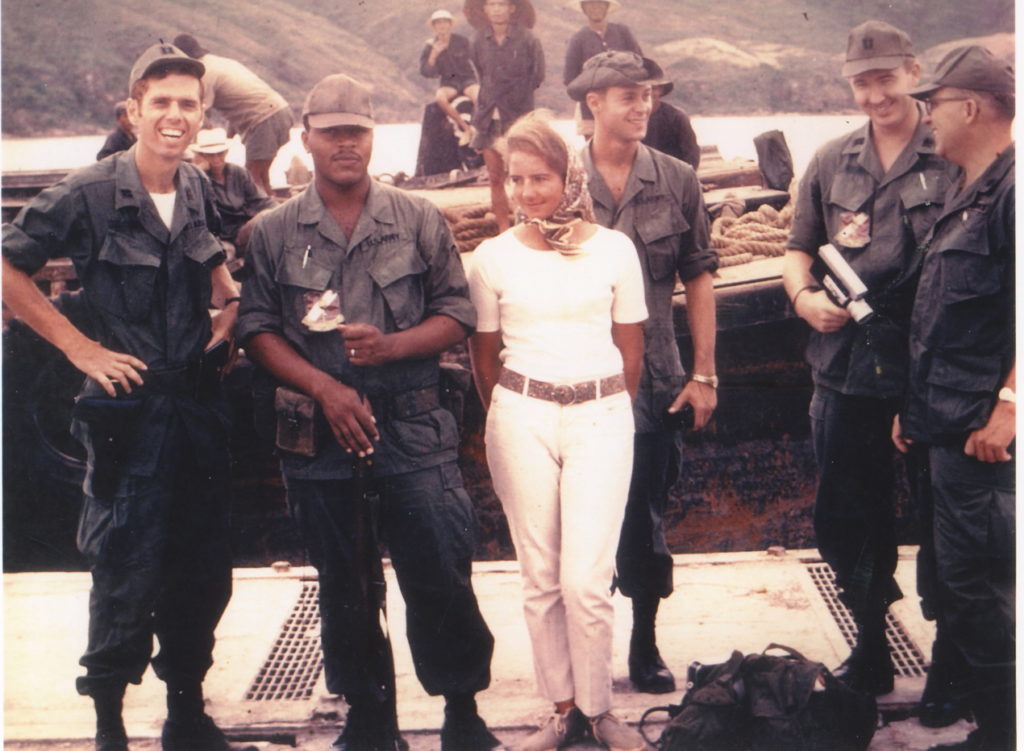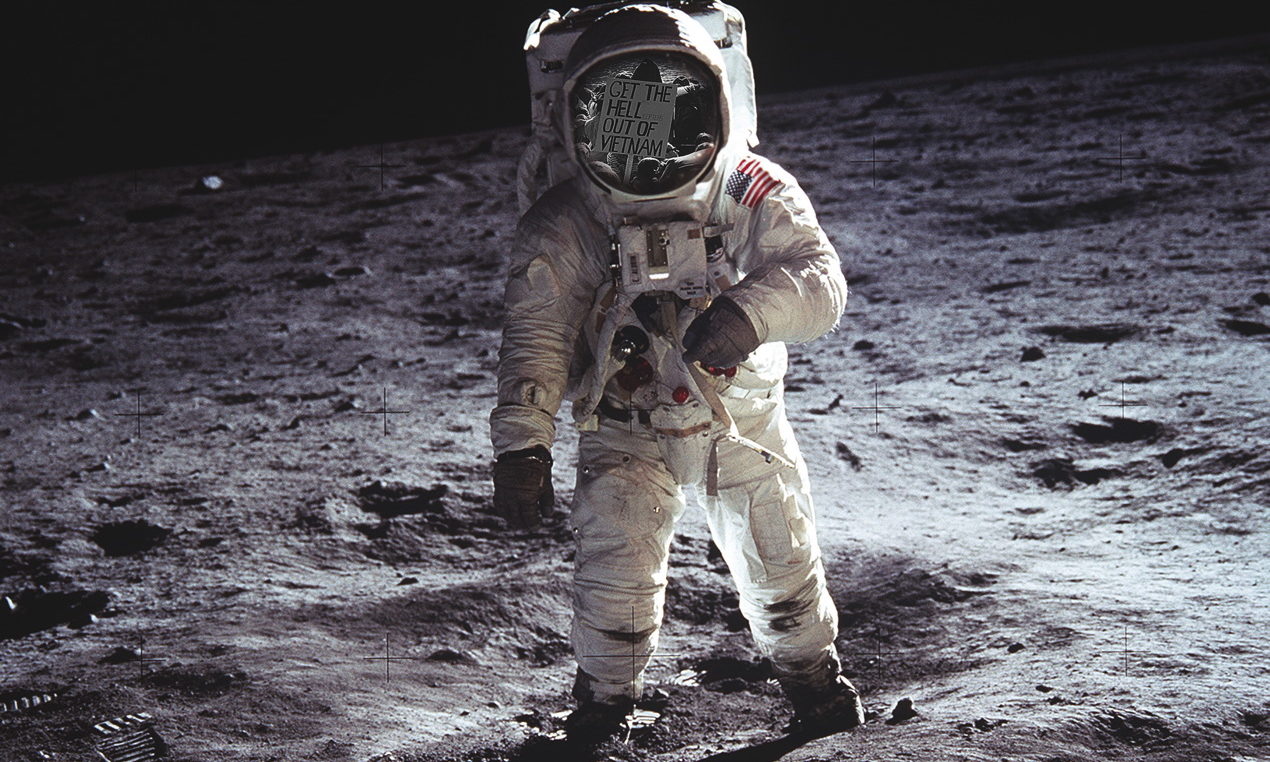A mixed picture
The US put a man on the moon and the Beatles era ended with a gig on a rooftop. Susan England looks at the ups and downs of 1969 and talks to two women who remember the year
Assuming office on 20 January 1969, US President Richard Nixon’s inauguration marked the beginning of a turbulent year in 20th century history that was largely dominated by America but took place as far away as the moon. Two men touched ground there, in the same year that four walked over the famous Abbey Road zebra crossing, 32,000 died on battlefields, 350,000 went to listen to live music in the New York mountains, and two million marched for peace.
The last year of the 1960s is known as the beginning of the end of the Vietnam War
The worldwide protests of 1968 weren’t repeated in 1969 but demonstrations began that January in objection to Nixon being sworn in. The National Mobilization Committee to End the War in Vietnam (MOBE) led the charge, and because of previous associations with violence, it strived for a peaceful event. The highlight was the counter-inauguration to Nixon’s lavish $2.3 million ceremony, of a hog they nominated in Chicago called Pigasus J Pig. The protests were largely non-violent – but did get messy. Accounts record the hurling of small burning flags and stones as well as horse manure.
The last year of the 1960s is known as the beginning of the end of the Vietnam War. Nixon knew it was vital to his presidential success and assumed responsibility to end it. But before he began to withdraw troops in June, he escalated the war by ordering the secret B–52 bombings of North Vietnamese camps in Cambodia.
“I went back to Vietnam because the children needed me,” Anne Watts, one of the few British civilian nurses working in Vietnam during the war, said of her return there in February 1969. She had completed an assignment with Save the Children in Qui Nhon, South Vietnam, during 1967 and 1968, before returning to Minh Quy Mission Hospital in Kontum.
“War injuries are horrific, particularly for children. We saw a lot of land mine injuries, so many of the children we cared for were missing one or more limbs. We also had two outbreaks of bubonic plague while I was there. You have to understand that everything breaks down in a war zone.”
The Summer of Love two years earlier seemed a hazy memory on the cold, windy January morning that the four Beatles, with Billy Preston on keyboards, headed to the rooftop of their Apple offices on Savile Row in London for their last public performance. It ended when a member of public called the police. In March Paul McCartney married Linda Eastham, swiftly followed by John Lennon and Yoko Ono, the latter couple embarking upon a weeklong Bed In for Peace in Amsterdam instead of a traditional honeymoon. They invited the press into their room at the Hilton to discuss the war in Vietnam and the peace movement.
They hosted a similar event in May in Montreal. Gail Renard, a Canadian teenager who looked after Ono’s daughter during the event, remembers the coverage of the war. “You couldn’t escape the Vietnam War. Even though there was no internet or 24/7 rolling news, everyone watched the evening news on TV and read the newspapers. It was very disturbing to see 18-year-old boys being sent to fight and die in a jungle when no one was sure why.”
The world, and the Fab Four who had provided much of the soundtrack to the sixties, needed more than love by 1969. The Beatles were on the verge of breakup, releasing Abbey Road, their final album, in October.
But there was a still a huge youth counterculture with a hunger for music. Possibly the most famous music festival to date took place in White Plains, New York on 15-18 August. Woodstock hosted acts including Jimi Hendrix, Janis Joplin, Joan Baez, The Who, Jefferson Airplane and Creedence Clearwater Revival. Approximately 350,000 attended the event. Festivals attended by 100,000 or more would also take place that summer in Atlanta, Georgia and the Isle of Wight. None came with the hefty price tags or extensive facilities of today’s omnipresent summer gatherings, giving them a genuine hippy ethos rather than the corporately produced aesthetic of many half a century later.
But that ethos was shattered in December at the Altamont Speedway Free Festival in California, headlined by the Rolling Stones. Hell’s Angels had been hired to police the event but turned violent and ran amok, attacking fans and band members, and eventually stabbing student Meredith Hunter to death.
More mainstream culture was available in cinemas, with 1969 credits including Butch Cassidy and the Sundance Kid, True Grit, Midnight Cowboy and Easy Rider in the US and The Italian Job, The Prime of Miss Jean Brodie, and Ken Loach’s social realist film Kes in the UK.
Dr Ian Scott, school director for social responsibility and internationalism at Manchester University, says the eclectic tastes of British film fans at the time are indicative of Britain’s mixed posture in 1969.
“UK cinema viewers were clamouring after a past that could be written as heroic if not nostalgic, while recognising deprivation and ways of life – in the north at least – hadn’t much changed over the course of the century so far. The films anticipate a downturn in economic fortunes – not least for the film industry – while still believing in some sustainable ‘never had it so good’ mentality.”
For marginalised groups there was little to be nostalgic about but progress was in sight. A year earlier the American Civil Rights Act passed, enshrining black rights in law, but in the early hours of 28 June 1969 another drawn-out battle for equality was sparked. A police raid on gay club the Stonewall Inn, in the Greenwich Village neighbourhood of Manhattan, is widely regarded at the trigger for the modern LGBT liberation movement in the US and beyond. At the time, it was illegal in most large US cities to solicit homosexual relations but New York also had a criminal statute that gave police the right to arrest anyone not wearing at least three or more articles of “sexually appropriate” clothing. Raids frequently took place but on that particular night clubbers decided to fight back.
The Stonewall riots lasted five days but soon became organised activism. Within six months, two gay activist organisations were formed in New York as well as three newspapers promoting gay rights.
The gay community was organising at home too. Bolton gay rights campaigner Allan Horsfall’s North West Committee for Homosexual Law Reform, founded two years earlier, became a UK-wide organisation, attracting support from leading figures in medicine, the arts and the church.
Progress was being made in science and technology too and one giant leap for mankind was made in 1969. Addressing the US Congress in May 1961, President John F Kennedy challenged America to “commit itself to achieving the goal, before this decade is out, of landing a man on the moon and returning him safely to the Earth”. Kennedy was assassinated in December 1963, but his vision was achieved on 20 July 1969 when Neil Armstrong took those famous first steps. The three-man crew, which also included Edwin “Buzz” Aldrin and Michael Collins, returned on 24 July. The Apollo Guidance Computer that got man to the moon had 64kb memory and operated at 0.043MHz – less powerful than a modern toaster.
Three months later, on 29 October, the first message via ARPANET (Advanced Research Projects Agency Network, a division of the American military), a precursor of today’s internet, was sent by student programmer Charley Kline. The message said simply “lo”, the intended word being “login”, but the system crashed after the first two letters were transmitted.
“It’s not overblown to suggest that the impact of the ARPANET – and by extension the internet – might be reasonably compared to that of the printing press in 15th century Europe. Both changed how contemporaries discovered their world, and both had major implications for the ‘business’ of politics, religion, war,” says Dr Sam Edwards, senior lecturer in American History at Manchester Metropolitan University and director of Manchester Centre for Public History and Heritage.
Both the Boeing 747 jumbo jet and the Anglo-French Concorde supersonic jet took their first test flights that year. Scott says: “Apollo 11 initiated the reusable Space Shuttle, and Jumbo and Concorde pointed the way towards faster travel for the masses and a discovery of the planet that huge swathes had only dreamed of on maps a decade or two beforehand. How could we not acknowledge that the future of comic sci-fi had finally arrived?”
But if sci-fi had arrived in the west, Southeast Asia was a dystopia. By the end of 1969 there had been human loss of 11,616 US citizens and 21,383 Southern Vietnamese. In the autumn opposition on US soil was gaining momentum. The Moratorium to End the War in Vietnam began in October 1969 as students across the country skipped classes in protest, rallies were held and prayer vigils took place.
An estimated two million Americans protested nationwide. A march in Washington, DC a month later had at least a half million in attendance.
But despite the protests the Vietnam War did not truly end until North and South Vietnam were reunited in 1975.
Edwards attributes this to Cold War thinking that led to the domino theory – that if one country fell to communism, neighbouring ones would do too. “Once the US committed to the defence of South Vietnam repeated American administrations found it impossible to exit without the appearance of defeat or loss of face.”
The US’s Second World War strategy of mobilising the economy, harnessing American industrial production, and using ever more powerful weapons to win also came under pressure. “North Vietnam was not the same sort of country – its military strategy, history, landscape, economy and governance were all different. It could not simply be bombed into submission 1940s style,” says Edwards.
The Vietnam War divided the generations in 1969, just as Brexit in the UK and the presidency of Donald Trump in the US continue to cause a rift between young and old in 2019.
“2019 might well be as dispiriting and hopeless as 1969 appeared to be at times then,” says Scott. “Whether the world has a whole decade to re-evaluate itself as it did back then is a moot point, however. Too much is now at stake, too many mistakes made, and too many wrong paths taken.”
But Edwards is hopeful. “The political and cultural upheaval of the 1960s has lots of lessons for today’s society. One clear lesson is the power of the people to contest the very shape and structure of a democratic society, and to strive for a better tomorrow, even in the face of what can seem insurmountable odds.
“Such movements and campaigns – often led by politically engaged young people who felt disenfranchised within their society – produced real change, secured in the face of very real and often violent resistance.”
How super-fan Gail Renard got to meet her hero

On 27 May 1969, 16-year-old Canadian Beatles fanatic Gail Renard heard on her crackly transistor radio that John Lennon and his new bride Yoko Ono were in Montreal, holding their famous Bed In for Peace and, like any good super-fan, she hopped on a bus to their hotel.
Arriving with hordes of other fans, she told a policeman she needed to interview Lennon for her school newspaper. He wasn’t impressed. Undeterred, she headed to the fire escape nearest Lennon’s hotel room. Scaling it, she realised the 17th floor, where Lennon was, would be full of security. She climbed to the 16th instead, and sneaked up a floor via an unguarded staircase.
A security guard was sipping a gigantic cup of coffee. She knew nature would soon call, so she waited. When it did, she sped to the door and knocked.
Ono answered and Renard asked for an interview. Ono invited her in just as she was about to be collared by the returning guard. Mission accomplished, she was introduced to Lennon and got the best school newspaper interview ever.
“John didn’t talk about the Beatles’ impending break-up,” says Renard. “The Beatles were number one in the world. John was on his honeymoon with Yoko. He was one happy man.”
When the interview was over Renard was invited to stick around. She helped control the fans and press, looked after Ono’s five-year-old daughter and joined in the first recording of Give Peace a Chance with Timothy Leary, Tommy Smothers, Petula Clark, Allen Ginsberg and many other 1960s cultural icons. Lennon looked after her, she says, sending her home every night to her mother, who had spoken to him on the phone and insisted that there were to be no drugs, drink or sex while her daughter was around.
“When the press wasn’t there, John would take out his guitar and sing for us,” she remembers. “John was one of greatest and most talented people I have ever met, and funny too. We stayed in touch, and he helped me become a writer.”
Renard chose this career despite being offered a position in Lennon’s entourage.
“Just eight days of being at the Bed In showed me what a lonely life it was – a succession of airports and hotel rooms and John being mobbed by screaming fans. It could be very scary at times. I also knew I wanted to go to university and become a writer. I made some incredibly mature decisions at 16!”
They paid off. Renard now lives in London and is TV chair of the Writer’s Guild of Great Britain, having won multiple awards for her writing, including a Bafta. Her book Give Me A Chance chronicles her Bed In adventure.
“It was always great that I could stay friends with John. I owe a lot to John and Yoko and I’ll always be grateful. I was the biggest Beatles fan then and still am now.”
Music’s importance amid the horrors of war

In Vietnam in 1969 Anne Watts became friends with an American soldier she remembers as Denny, who volunteered at Minh Quy Mission Hospital, where she worked.
“He was from Evansville, Illinois,” she recalls. “His parents owned a potato farm. I think coming to Vietnam might have been the most exciting thing that ever happened to him.
“He was incredibly shy among Western women, as were many of the soldiers. We could understand how difficult it must be for them to suddenly be confronted with women who might remind them of their own sisters or mothers back home.”
The soundtrack to 1969 reached the hospital via Denny, who loved playing guitar. “My favourite memory is of him tip-toeing through the masses of straw mats on the floor where we did our best to care for our patients – there were no neat rows of beds. Denny would always politely ask if he could play for the children. His favourite song was Hey Jude by the Beatles. He would sit on a mat amongst the children and gently strum away and sing to them.”
Haio, a local teenager employed as a health assistant in the hospital lab, listened intently to Denny’s music, but never asked to play the guitar as some of the children did, says Watts, who was born in Liverpool and studied nursing at Manchester Royal Infirmary.
The loyal hospital employee had been a patient at Minh Quy after a land mine shredded his lower leg. A rudimentary prosthesis, crafted by dedicated American volunteer Dr Patricia Smith, allowed him to walk again.
“Even with his injury, he was our joker. He was so much fun, and was just a joy to be around,” says Watts, who has written accounts of her travels as a nurse in her books Always the Children and A Nurse Abroad.
When Denny was killed in action, it hit Haio the hardest. Another soldier brought Haio Denny’s tape recorder with a supply of batteries, a tape of Beatles songs as well as others, and his beloved guitar.
“We were all devastated and cried, but work must go on. But Haio disappeared for a few days into the mountains to grieve for his friend. When he returned he always had that battered tape recorder with him, asking for more batteries when any of the soldiers were going on a break. He played that Beatles tape, and Hey Jude in particular, over and over,” says Watts.
“One day he picked up the guitar and played it in his spare time until he mastered the tune. He couldn’t play anything else, but his rendition of Hey Jude was beautiful.
“Anytime I hear that song now, I am taken immediately back to those mountains in Southeast Asia and the smiling Montagnard boy with his limping gait playing Hey Jude in tribute to his friend.”

Leave a reply
Your email address will not be published.